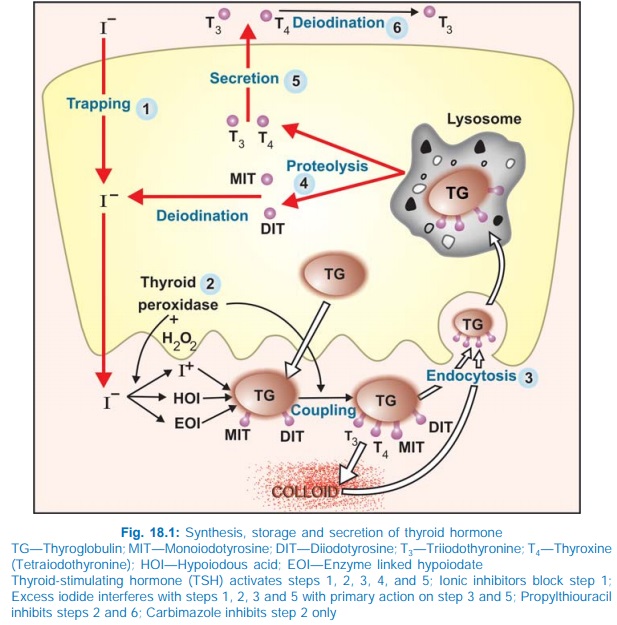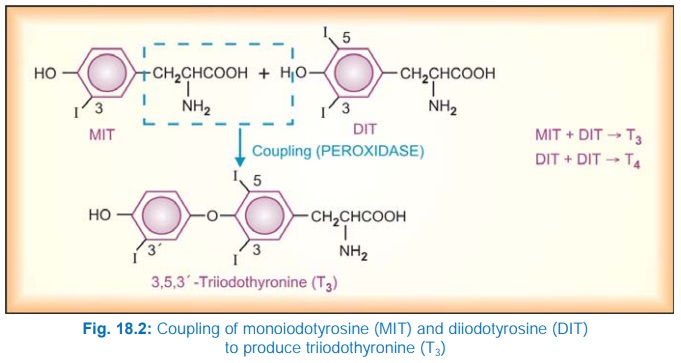Synthesis of Thyroid Hormone
| Home | | Pharmacology |Chapter: Essential pharmacology : Thyroid Hormones And Thyroid Inhibitors
The thyroid hormones are synthesized and stored in the thyroid follicles as part of thyroglobulin molecule—which is a glycoprotein synthesized by thyroid cells, MW 660 KDa, contains 10% sugar. The synthesis, storage and release of T4 and T3 is summarized in Fig. 18.1 and involves the following processes.
SYNTHESIS OF THYROID HORMONE
The thyroid hormones
are synthesized and stored in the thyroid follicles as part of thyroglobulin molecule—which is a
glycoprotein synthesized by thyroid cells, MW 660 KDa, contains 10% sugar. The
synthesis, storage and release of T4 and T3 is summarized
in Fig. 18.1 and involves the following processes.

1. Iodide Uptake
The total body content of I2, obtained from food and water, is 30–50 mg, out
of which about 1/5 is present in the thyroid. Concentration of iodide in blood
is low (0.2–0.4 μg/dl) but thyroid cells have an active transport process (Na+: I¯
symporter or NIS) to concentrate this anion; this trapping is stimulated by TSH
to exceed a gradient of more than 100 fold. The I2 content of
thyroid gland somehow regulates the uptake mechanism: meagre store activating
and large store inhibiting it. The iodide concentrating mechanism is not
peculiar to thyroid; skin, salivary glands, gastric mucosa, intestine, mammary
glands and placenta also possess it, but uptake in these organs is not stimulated
by TSH.
2. Oxidation And Iodination
Iodide trapped by follicular cells is carried across the apical membrane by another transporter termed ‘pendrin’ and oxidized by the membrane bound thyroid peroxidase enzyme to iodinium (I+) ions or hypoiodous acid (HOI) or enzymelinked hypoiodate (EOI) with the help of H2O2. These forms of iodine combine avidly with tyrosil residues of thyroglobulin, apparently without any enzymatic intervention, to form monoiodotyrosine (MIT) and diiodotyrosine (DIT) while the residues are still attached to the thyroglobulin chains.
3. Coupling
Pairs of iodinated tyrosil residues couple together (Fig. 18.2) to form T3
and T4. Normally much more T4 than T3 is formed,
but during I2 deficiency relatively more MIT is available and a
greater proportion of T3 is formed. Thus, more active hormone is
generated with lesser amount of I2.

Coupling
is an oxidative reaction and is catalysed by the same thyroid peroxidase.
Thyroglobulin
is the most efficient protein in supporting coupling by providing favourable
spatial configuration to facilitate the reaction. Oxidation of iodide and
coupling are both stimulated by TSH.
4. Storage And Release
Thyroglobulin containing iodinated tyrosil and thyronil residues
is transported to the interior of the follicles and remains stored as thyroid
colloid till it is taken back into the cells by endocytosis and broken down by
lysosomal proteases. The T4 and T3 so released is
secreted into circulation while MIT and DIT residues are de-iodinated and the
iodidereleased is reutilized. The uptake of colloid and proteolysis are
stimulated by TSH: the quiscent gland
has follicles distended with colloid and cells are flat or cubical, while the
TSH stimulated gland has columnar cells and colloid virtually disappears.
Normal human thyroid secretes 60–90 μg of T4 and
10–30 μg of T3
daily.
5. Peripheral Conversion Of T4 To T3
Peripheral tissues, especially
liver and kidney, convert T4 to T3. About 1/3 of T4
secreted by thyroid undergoes this change and most of the T3 in
plasma is derived from liver. Target tissues take up T3 from
circulation for their metabolic need, except brain and pituitary which take up
T4 and convert it to T3 within their own cells. Almost
equal amounts of 3, 5, 3´ triiodothyronine (normal T3 : active) and
3, 3´, 5´ triiodothyronine (reverse T3: inactive) are produced in
the periphery. Propylthiouracil (but not carbimazole), propranolol (high doses),
amiodarone and glucocorticoids inhibit peripheral conversion of T4
to T3 (except in brain and pituitary).
Related Topics
